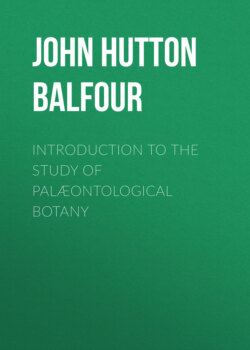Читать книгу Introduction to the Study of Palæontological Botany - John Hutton Balfour - Страница 3
На сайте Литреса книга снята с продажи.
PREFACE.
ОглавлениеTable of Contents
The subject of Fossil Botany or Palæophytology has formed a part of the Course of Botany in the University of Edinburgh for the last twenty-five years, and the amount of time devoted to the exposition of it has increased. The recent foundation of a Chair of Geology and of a Falconer Palæontological Fellowship in the University seems to require from the Professors of Zoology and Botany special attention to the bearings of their departments of science on the structure of the animals and plants of former epochs of the Earth's history. No one can be competent to give a correct decision in regard to Fossils, unless he has studied thoroughly the present Fauna and Flora of the globe. To give a well-founded opinion in regard to extinct beings, it is essential that the observer should be conversant with the conformation and development of the living ones now on the earth; with their habits, modes of existence and reproduction, the microscopic structure of their tissues, their distribution, and their relation to soil, the atmosphere, temperature, and climate.
There can be no doubt that to become a good Fossil Geologist a student must begin with living animals and plants. The study of Geology must be shared by the Petralogist, who looks at the condition of the rocks of the globe, the minerals forming them, and their mode of formation; the Chemist, who determines the materials which enter into the composition of minerals and rocks; the Naturalist, who examines the plants and animals found in the various strata; and perhaps also the Natural Philosopher, who calculates from independent sources the phases of the Earth's history. It may be said thus to combine all these students of Science in one brotherhood. Much has been done by the efforts of such men as Hutton and Werner, who were engaged chiefly in considering the mineral department of Geology; but it is clear that the Science could not have attained its present position without the continued labours of those who have been examining fossils in their relations to time and space. Had it not been for the researches of Palæontologists, Geology could not have made its present advance.
In my Class Book of Botany I have given an introduction to Palæophytology, and it occurred to me that it might be useful to students to publish this in a separate form, with additions in both the letterpress and the illustrations. The institution of the Palæontological Fellowship, in memory of my former friend Dr. Falconer, has brought the subject specially under my notice. The Fellowship has been promoted chiefly by my friend and former pupil Dr. Charles Murchison, a gentleman fond of science and of his Alma Mater, the University of Edinburgh, where he and Falconer studied and took their degrees.
The first award of the Fellowship has been made to a distinguished student, who acquitted himself with the greatest credit during the three days of examination on Geology, Zoology, and Botany. I trust that the Fellowship will continue to stimulate our eminent students in future years.
Having been a student of Natural Science along with Dr. Falconer, I feel a peculiar interest in doing what I can to promote the study of a subject to which he so successfully devoted his energies. In my endeavour to do so I have been encouraged by my friend and former pupil, Mr. William Carruthers, at the head of the Botanical Department of the British Museum, and a former student in Edinburgh under the late Professor Fleming. He has done much to advance our knowledge of Fossil Botany, and to him I am indebted for two of the plates and some of the woodcuts which illustrate this publication. He has given me most efficient assistance, and I have to return my best thanks for his kind aid. I am also indebted to my colleague, Professor Geikie, for his valued assistance.
The neighbourhood of Edinburgh is rich in Fossils of the Carboniferous epoch, and much yet remains to be done to illustrate its Palæontology. Such labourers as Geikie and Peach may be expected to give great assistance in the furtherance of our knowledge of Scottish Geology, so as to form a school which shall revive the reputation enjoyed by Edinburgh in the days of Hutton and Jameson. If I can be useful in encouraging students to take up the study of Palæontological Botany, and to prosecute it with vigour, I shall feel that this introductory treatise has not been issued in vain. As one of the few surviving relations of Dr. James Hutton, I am glad to be able to show an interest in a science which may aid in elucidating the "Theory of the Earth."
In writing this work I have taken for granted that the reader is acquainted with the Elements of Botany, and knows the general structure of plants of the present day. I have not, therefore, hesitated to use the ordinary Botanical terms without explanation. I am satisfied that no one can study Fossil Botany properly unless he has studied Modern Botany.
Those readers who may find any difficulty as to technical terms I would refer to my Botanist's Companion, where a full Glossary is given.
27 Inverleith Row,
May 1872.
